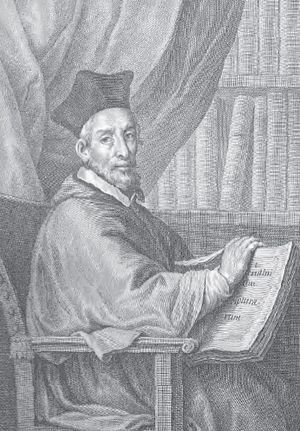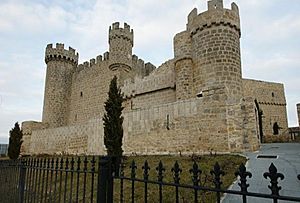Paul of Burgos facts for kids
Paul of Burgos (Burgos, c. 1351 – 29 August 1435) was a Spanish Jew who converted to Christianity, and became an archbishop, lord chancellor, and exegete. He is known also as Pablo de Santa María. His original name was Solomon ha-Levi.
Early life
He was the most wealthy and influential Jew of Burgos, an erudite scholar of Talmudic and rabbinical literature, and a rabbi of the Jewish community. His father, Isaac ha-Levi, had come from Aragon to Burgos in the middle of the fourteenth century. Solomon ha-Levi also apparently filled the office of tax-farmer at the same time.
According to Graetz, his scholarship and intelligence, no less than his piety, won the praise of Isaac ben Sheshet, with whom he carried on a learned correspondence. This assertion is disputed by Atlas and Hershman as anachronistic; "...the disparity in age between Paul de Burgos and Perfet renders the assumption of Graetz untenable."
Conversion
He received Christian baptism on 21 July 1391 at Burgos, taking the name Paul de Santa María. French historian Leon Poliakov writes that he converted in the aftermath of the great massacres of Jews which began on 6 June 1391. He himself said that he had been convinced by the works of Thomas Aquinas. The official Catholic Church records show that he had converted to Christianity a year earlier (at 21 July 1390), but studies attribute this record forgery to Paul himself, who wanted to show that it wasn't the pressure of the massacre that instigated his baptism. At the same time his brothers Pedro Suárez and Alvar García, his sister María Nuñez, and his children, one daughter and four sons, aged from three to twelve years, were baptized. His wife, Joanna Benvenisti, whom he had married in his twenty-sixth year, remained faithful to Judaism, dying in that faith in 1420; she was afterward buried in the Church of S. Pablo, built by her husband.In 1406, following a law allowing Jews to return to Judaism, their daughter Beatrice and their youngest son Todros returned to Judaism.
Later life
Paul spent some years at the University of Paris, receiving the degree of doctor of theology after several years. He then visited London, where he probably remained only a short time, sending a Hebrew satire on Purim to Don Meïr Alguades from that city.
He was appointed archdeacon of Treviño, and in 1402 (or 1405) became Bishop of Cartagena; and in 1415, Archbishop of Burgos. He was succeeded in the see of Burgos by his second son, Archbishop Alfonso of Burgos.
His intelligence and scholarship, as well as his gift of oratory, gained for him the confidence of King Henry III of Castile, who in 1406 appointed him keeper of the royal seal, in succession to Pero Lopez de Ayala. In 1416 King Henry named him Lord Chancellor. After the king's death Archbishop Paul was a member of the council which ruled Castile in the name of the regent Doña Catalina, and by the will of the deceased king he was tutor to the heir to the throne, the later John II of Castile. After the death of Bishop Pablo de Santa María, which occurred on August 30, 1435, his body was buried in the main chapel of the Friary [Convent] of S. Pablo [Saint Paul] of Burgos (which no longer exists; the site is now used by the Museum of Human Evolution), where several members of the Cartagena family were later buried.The remains of all of them lay in different tombs in the form of an arcosolium placed in the main chapel, and on the floor of the same chapel were six tombstones of slate and alabaster under which the remains of as many members of the Cartagena family rested.The members of this family who were buried in the main chapel were:
- Paul of Santa Maria (c.1350-1435). Bishop of Burgos and Cartagena
- Pedro de Cartagena (1388-1478). Alderman of the city of Burgos and son of the previous one.
- Maria de Sarabia. Wife of Pedro de Cartagena.
- Mencía de Rojas. Wife of Pedro de Cartagena.
- Lope de Rojas (d. 1477). Canon of the Cathedral of Burgos and son of Pedro de Cartagena and Mencía de Rojas.
- Álvaro Pérez de Cartagena (d. 1471). Son of Pedro de Cartagena.
- Gonzalo de Santa María (1379-1448). Bishop of Gerona, Plasencia, Astorga and Sigüenza and son of Bishop Pablo de Santa María.
- Alonso de Cartagena (d. 1507). Son of Alonso de Cartagena and Inés de Villalobos.
- Ana de Leiva. Wife of the previous and daughter of Juan de Leiva and Constanza de Mendoza.
- Juan de Cartagena (1500-1533). Son of Alonso de Cartagena and Ana de Leiva.
- Pedro de Cartagena (1502-1533). Son of Alonso de Cartagena and Ana de Leiva.
- Inés de Mendoza and Cartagena. Daughter of Alonso de Cartagena and Ana de Leiva.
In the presbytery was placed a small choir stalls for the friars, and the chair of the father prior of the convent was near the altar of St. Hyacinth. In 1865, a cinerary urn that is supposed to contain the mortal remains of Bishop Pablo de Santa María was taken to the cathedral of Burgos and placed in the chapel of the Visitation, next to the tomb of his son, Bishop Alfonso de Cartagena.
Relationship to Judaism
Paul, who even after he had been baptized continued to correspond with several Jews, including Joseph Orabuena, chief rabbi of Navarre, and Joshua ibn Vives, became a bitter enemy of Judaism. He tried his best, frequently with success, to convert his former coreligionists.
In the same spirit the chief object of the edict which he drafted as chancellor of the kingdom, and which was promulgated in the name of the regent, the widowed queen mother Catherine of Lancaster, at Valladolid on January 2 (not 12), 1412, was the conversion of the Jews. This law, which consisted of twenty-four articles, was designed to separate the Jews entirely from the Christians, to paralyze their commerce, to humiliate them, and to expose them to contempt, requiring them either to live within the close quarters of their ghetto or to accept baptism.
Impelled by his hatred of Talmudic Judaism, Paul in the year preceding his death composed the Dialogus Pauli et Sauli Contra Judæos, sive Scrutinium Scripturarum (Mantua, 1475; Mayence, 1478; Paris, 1507, 1535; Burgos, 1591), which subsequently served as a source for Alfonso de Spina, Geronimo de Santa Fé, and other Spanish writers hostile to the Jews, and Martin Luther in Germany for his treatise On the Jews and their Lies. A few years after his baptism he wrote Additiones (which consist of addenda to Nicholas of Lyra's postils on the Bible, and have been frequently printed), and in his old age a Historia Universal in Spanish verse.
Works
The published writings of Archbishop Paul were:
- Dialogus Pauli et Sauli contra Judæos, sive Scrutinium scripturarum (Mantua, 1475; Mains, 1478; Paris, 1507, 1535; Burgos, 1591).
- Additiones to the Postilla of Nicholas of Lyra (Nuremberg, 1481; 1485; 1487, etc.; Venice, 1481, 1482, etc.).
It is chiefly on the latter work that Paul's reputation as an exegete rests. The Additiones were originally mere marginal notes written in a volume of the Postilla which he sent to his son Alfonso. Their publication aroused Matthias Döring, the provincial of the Saxon Franciscans, to publish his Replicæ, a bitter rejection of almost half of the 1,100 suggestions and additions Paul had made.
- De nomine divino quæstiones duodecim (Utrecht, 1707).
These tracts are excerpts from the Additiones in regard to Exodus iii, and are joined to the scholia of J. Drusius on the correct pronunciation of the name of Jahweh.
See also
 In Spanish: Pablo de Santa María para niños
In Spanish: Pablo de Santa María para niños
- Alfonso de Cartagena
- Álvar García de Santa María
- Gonzalo de Santa María
- Teresa de Cartagena
- Francisco de Vitoria
- Isabel Osorio



